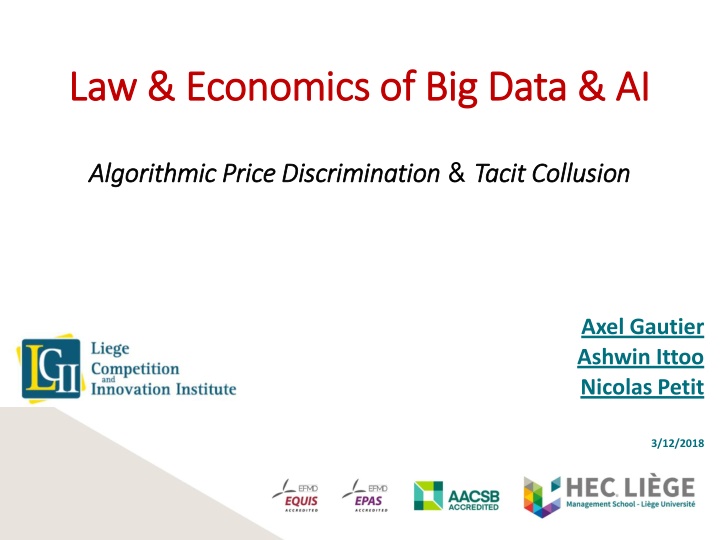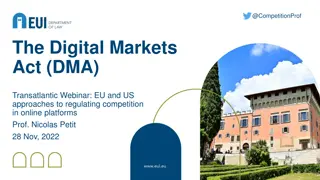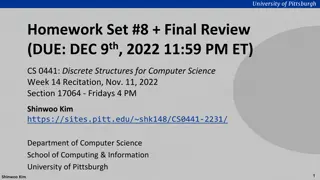
AI in Pricing Strategies: Economic & Legal Perspectives
Explore the economic and legal implications of AI in pricing strategies, including price discrimination and tacit collusion. Learn how AI extends the possibilities of personalized pricing and facilitates collusion through algorithms.
Download Presentation

Please find below an Image/Link to download the presentation.
The content on the website is provided AS IS for your information and personal use only. It may not be sold, licensed, or shared on other websites without obtaining consent from the author. If you encounter any issues during the download, it is possible that the publisher has removed the file from their server.
You are allowed to download the files provided on this website for personal or commercial use, subject to the condition that they are used lawfully. All files are the property of their respective owners.
The content on the website is provided AS IS for your information and personal use only. It may not be sold, licensed, or shared on other websites without obtaining consent from the author.
E N D
Presentation Transcript
Law & Law & Economics Economics of of Big Big Data & AI Data & AI Price Discrimination Discrimination & Tacit Algorithmic Algorithmic Price Tacit Collusion Collusion Axel Gautier Ashwin Ittoo Nicolas Petit 3/12/2018
Agenda 1. 2. Introduction Price Discrimination Discussion Economic Foundations Legal Aspects Data & AI 3. Collusion 4. Discussion
Introduction Introduction Dominant forms of AI Machine/Deep Learning (Deep) Reinforcement Learning Firms using AI for pricing algorithms Learn how to price optimally Learning from past data (example on next slide) Giving rise to new concerns, new questions
1. Introduction 1. Introduction ( (cont cont) ) Illustration: Machine Learning Learning from past data Learning to predict Willingness To Pay (WTP) Predicted Variable (Supervised Learning) Predictors
1. Introduction ( 1. Introduction (cont cont) ) Research Focus: AI (&Big Data) on Price Discrimination Tacit Collusion Specifically: Does AI Extends the possibility to price discriminate leading to more personalized prices (Belleflamme et al., 2018)? Facilitates collusion by algorithms (Ezrachi and Stucke, 2016)?
Overview: Methodology & Results Overview: Methodology & Results Methodology Grounded in Economic, AI & Legal Scientific Literature Compare Price Discrimination (PD) and Tacit Collusion (TC) Main result: PD & TC diametrically opposed Data requirements AI methods Strategies (more complex for TC) Context (one-shot v. repeated games)
2. Price Discrimination (PD) / Personalized Pricing (PC)
2.1 Economic Foundations 2.1 Economic Foundations Third-degree price discrimination Customers segmented in different groups Different prices offered to each group Group Pricing Clustering algorithms Similar customers same groups/segments Similarity based on observable characteristics, e.g.demographics Age, Sex, Location, Salary,
2.1 Economic Foundations (cont) 2.1 Economic Foundations (cont) Group pricing in monopoly increased profits Output expansion (as compared to uniform pricing) Surplus extraction => efficient Finer grained segmentation increased profits Large number of (small) clusters Extreme case: 1 customer = 1 cluster From 3rd to 1st Degree PD
2.2 Data & AI 2.2 Data & AI Several real-life PD cases reported Local grocery store or pharmacy Tailored pricing Not overt: labelled as personalized deals or coupons [Elliot [2013], Gross [2012]]. See Shiller 2014 Staples Pricing based on Location, Distance from competitors stores Discounts if competitors within 20 miles of Staples store See WSJ Article
2.2 Data & AI (cont) 2.2 Data & AI (cont) TravelVelocity Pricing based on Browser (IE, FireFox, IE) Platform (OSX, iOS, Android, Windows) Account log-in Amazon Clearing cache, deleting cookies Drop in DVD price: $26.24 to $22.74 Customers refunded
2.2 Data & AI (cont) 2.2 Data & AI (cont) Most real-life examples Instances of 3rd degree PD, albeit more graunular E.g. distance (customer, Staples) > 20 miles 1 segment But Does AI (&Big Data) lead to more personalized prices?
2.2 Data & AI (cont) 2.2 Data & AI (cont) Advent of digital platforms Consumers revealing Personal & demographic Age, sex, location, education, device, Behavioral information breadcrumbs Likes (preferences), sentiments, opinions, purchase patterns Information breadcrumbs Enable reconstruction of digital personae Fairly accurate profile of consumers Guess WTP of consumers
2.2 Data & AI (cont) 2.2 Data & AI (cont) Past research Empirical evidence Machine Learning/Econometrics Methods Applied to customer data More granular 3rd degree PD Tends towards 1st degree PD See for e.g. Shiller, 2014 Ban & Keskin, 2017 Dub & Misra, 2018 (Summary in following slide) Supported by documented real-life PD cases
Data & AI (cont) Data & AI (cont) ML/Econ. Methods Data Demographic + Behavioral Main Results (w.r.t. PD) (Netflix) Race, age, income, population density, web browsing behavior, Ordered-choice Model Averaging (OMA), Profits increase by 12.2% more than 2nd degree PD profits Shiller (2014) Ban & Keskin (2017) Gender, income bracket, age, height, and weight Least square, Lasso Regressions Devised near-optimal pricing policy (min. regret) Dub & Misra (201) (Ziprecruiter) Job state, company category, job category, benefits Lasso, Weighted likelihood Bayesian bootstrap Profit increase: > 10% Customer surplus declines: > 1%..but 70% of customers pay less
2.3 Discussion 2.3 Discussion Big Data, AI More sophisticated pricing algorithms Finer-grained segments Facilitate Price Discrimination But No clear consensus if PD is an economic equilibrium in a competitive environment
2.3 Discussion (cont) 2.3 Discussion (cont) Dual impact of PD in competitive environment Output expansion ( Profits) Intensified competition ( Profits) General consensus from the literature: Too much retail competition is incompatible with price discrimination Similar datasets, algorithms leads to collapse of price discrimination (Liu & Serfes, 2004; Belleflamme et al. 2018) Important to consider retail & data market when analyzing the impact of AI on PD For economic equilibrium: need absence of competition on retail and data markets
2.4 Law & Policy Aspects In EU law, Article 102 c) does not capture PD targeted to consumers (end users), but Article 102 a) captures unfair pricing => possible legal basis to use when all surplus is extracted Threshold level of dominance : Only applies to 3rd of 1st degree PD by monopoly, not in competitive markets Article 102 b) could be used : output limitation => when PD is successfully deployed, there are no longer gains from trade for buyers => markets collapse in the long term Also for these laws are possibly applicable for price discrimination: Consumer protection, gdpr Data protection Anti discrimination And competition law, could be interesting as it follows a case by case approach
3.1 3.1 Economic Economic Foundation Foundation Collusion without formal agreement Oligopoly markets May emerge as repeated game equilibrium Based on grim-trigger strategy Play the collusive outcome at date t, if the other player(s) has played the collusive outcome at all date t <t Play the non-collusive (or competitive) outcome otherwise Constitutes (under conditions) subgame perfect Nash equilibrium (SPNE) Non-unique SPNE (Folk theorems) Non-collusive outcome is a SPNE of the game Possible to sustain collusion for different collusive prices Possible to sustain equilibria with limited punishment periods, e.g. if a player deviates from the collusive outcome, play the non collusive outcome for T periods and then return to the collusive one . If T is large enough, it can sustain a SPNE
3.1 Economic Foundation (cont) 3.1 Economic Foundation (cont) 3 conditions for collusive outcome 1. Meeting of the minds (coordination) on a collusive price (or output level) 2. Monitoring device 3. Credible punishment Cornerstone of collusive strategies Losses incurred from punishment at least cancel benefits of cheating Optimal response of competitors after deviation
3.2 Data & AI 3.2 Data & AI Intuitively AI Algorithms facilitate price monitoring Increase market transparency Does AI increase occurrences of (algorithmic) tacit collusion?
3.2 Data & AI (cont) 3.2 Data & AI (cont) (Tacit) Collusion Formalized as Reinforcement Learning (RL) problem RL: class of AI paradigm RL Agent Explores its environment Learns best (optimal) sequence of actions to reach goal Actions yield rewards (positive scalar or zero)
3.2 Data & AI (cont) 3.2 Data & AI (cont) RL Illustration Agent s Goal: Find optimal solution to reach state 5 (exit the building) Optimal solution : action sequence that yields highest rewards Actions: up, down, right, left Agent learns about different solutions via exploration
3.2 Data & AI (cont) 3.2 Data & AI (cont) Q-Learning Classical algorithm for RL Variants: Nash Q-Learning, Independent Q-learning Empirical evidence on collusion between Q-Learning agents Klein (2018) Calvano et al. (2018) Harrington (2017) But current research Simplistic duopoly environments, not accurate reflection of real-life (oligopoly, with n competing agents, n >2) Non-stationary environment with n > 2 agents; Q-learning fails Punishment mechanism overlooked, except in Calvano et al.
3.3 Discussion 3.3 Discussion General conclusion Multiplicity (and complexity) of equilibria is a concern (in coordinating and punishment) Overcome in restricted, laboratory environments Given current state of the art in AI and the issue of multiple, complex equilibria : Doubtful if algorithmic tacit collusion can occur in real- life
3.3 Law & Policy Aspects It is communication that is illegal in collusion. So, if algorithmic agents do not communicate > no collusion...nothing different to human collusion But tacit collusion can be indirectly remedied in merger proceedings 4 to 3 merger leading to increased risks of tacit collusion Collusion has always existed . Do we need new laws for algorithmic collusion? (no different from human collusion) Perhaps if tacit collusion occurs at scale Idea would to legally fight collusive outcome (parallel pricing) instead of incriminating collusive process (communication) Pure economic approach (Kaplow)
Conclusion Conclusion AI & Big Data undoubtedly facilitate Price Discrimination (PD) But is PD an equilibrium in a competitive environment? Important to consider retail & data markets when analyzing the impact of AI on PD For equilibrium: limited competition on retail & data markets AI & Big Data increase market transparency But can algorithmic agents can collude in real-world? Still an open-research question Issues of multiple equilibria, complexity of equilibria State of the art AI not sophisticated enough to capture mechanisms of collusive strategies, especially punishments
Conclusion (Contd) TC and PD/PP do not work well together When PD/PP is possible, oligopolists algorithms can cheat on each customer (C) anarchy (see diagram on next slide) Unless TC on each price point on the demand curve, TC is not a stable equilibrium TC occurs on usual range of output , but PD/PP occurs on the marginal range of output unserved under TC Note : TC is less efficient than PD/PP. Policy should focus on TC ? Note 2 : TC is less frequent than PD/PP. Policy should focus on PD ?
Conclusion (cont) PD TC Game Static or dynamic Dynamic Data needed Customers characteristics Pricing of competitors, sales volume AI ML to cluster consumers and infer WTP Design targeted discount RL Algo. agent explores environments, learns optimal action sequence to max. profits Pricing Personalized price, random prices, personalized discounts Linear/flat pricing





















